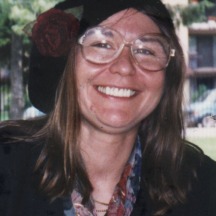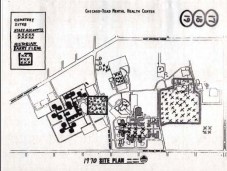She came into thousands of Northwest side Chicago homes every week and was simply known as “Terri”. You need to know her.
 Theresa “Terri” Ann Kruszczak (1956-1998) was the most capable staff writer and managing editor of the Times’ six weekly editions, the largest group of the Lerner Community Newspapers, later known as Pulitzer–Lerner newspapers. Terri tirelessly attended community meetings, neighborhood events and school board proceedings in search of her next story.. She wrote thousands of articles that appeared weekly in the Harlem Irving Times, Jefferson Mayfair times, Harlem Foster Times, northwest times, Uptown News Star and other editions. After dinner, she would often return to her office alone late at night to write that one more story before deadline.
Theresa “Terri” Ann Kruszczak (1956-1998) was the most capable staff writer and managing editor of the Times’ six weekly editions, the largest group of the Lerner Community Newspapers, later known as Pulitzer–Lerner newspapers. Terri tirelessly attended community meetings, neighborhood events and school board proceedings in search of her next story.. She wrote thousands of articles that appeared weekly in the Harlem Irving Times, Jefferson Mayfair times, Harlem Foster Times, northwest times, Uptown News Star and other editions. After dinner, she would often return to her office alone late at night to write that one more story before deadline.
Her professional life changed forever in March of 1989 when bones and dead bodies were uncovered on the site of the Cook County Poorhouse and Insane Asylum, later renamed the Chicago State hospital.
Weekly headlines revealed a gruesome story every week:
 “Remains Found at Dunning Work Site”, “ Bone sites multiply”, “Discovery of remains halts project”, “Civil War vet burial could jinx developers”
“Remains Found at Dunning Work Site”, “ Bone sites multiply”, “Discovery of remains halts project”, “Civil War vet burial could jinx developers”
“Bones litter the site. Long leg bones and pieces of skulls protrude from piles of dirt. Outlines of bodies can be seen in trenches.” Bones of Human skeletons have remained laying on the ground for over two months after they were uncovered during excavation work”
Please read on to meet the very special and talented Theresa “Terri” Ann Kruszczak, who as part of her work as a reporter and newspaper editor helped preserve a lost cemetery.
 This story which appeared during the week of March 29-30 1989 began the finest work of her career, writing accurate, fair and compassionate articles about the rediscovery of Cook County Cemetery at Dunning and the 38,000 forgotten souls buried underneath. Her work became an award-winning series on the debate over moving or destroying the cemetery at Dunning to make an easier way for residential and commercial developments in the Read-Dunning area. Her work reporting the rediscovery of the lost cemetery had a profound effect on how well the cemetery issue was handled and how the burials would someday be partially preserved. She made sure that those souls buried there would not ever be forgotten.
This story which appeared during the week of March 29-30 1989 began the finest work of her career, writing accurate, fair and compassionate articles about the rediscovery of Cook County Cemetery at Dunning and the 38,000 forgotten souls buried underneath. Her work became an award-winning series on the debate over moving or destroying the cemetery at Dunning to make an easier way for residential and commercial developments in the Read-Dunning area. Her work reporting the rediscovery of the lost cemetery had a profound effect on how well the cemetery issue was handled and how the burials would someday be partially preserved. She made sure that those souls buried there would not ever be forgotten.
Terri went on to write over 70 in depth articles between March of 1989 and 1995 about the cemetery and its fate. Her work can be found within the news articles section of www.Cookcountycemetery.com. Because of her local coverage in the Lerner Papers and excellent coverage other local newspapers, the uncovering of such a large cemetery attracted the attention of news media, both local and nationwide. Associated Press sent the story out to papers across the country, and articles began appearing as far as Los Angeles, California. The story appeared on several Chicago radio and television stations, one broadcast entitled “Mysterious Bones”
Associated Press sent the story out to papers across the country, and articles began appearing as far as Los Angeles, California. The story appeared on several Chicago radio and television stations, one broadcast entitled “Mysterious Bones”
All this coverage was because Terri relentlessly and truthfully told the whole story as it happened in the Lerner Papers for several years.
Bodies were found in many sections of the 320 acre property, not just in the two well defined cemeteries.
In the aerial photograph below, the area in orange was the original cemetery, also referred to as the “old grounds” of about twenty acres and used until 1890. The purple area is the 5.71 acre “new grounds” opened in 1890 and used well into the 1920’s before it too filled to capacity. . In 1912, when the State of Illinois bought the property, this section was then named “Chicago State Hospital Cemetery” on death certificates.
Terri walked both these areas many times, gathering the facts and seeing for herself bodies that had been uncovered. She interviewed myself the researcher and Pastor Bill Brauer the tireless advocate for preservation of the cemetery, as well as the builders, archeologist, city, county and state officials, former employees of the institution, and even neighbors who remembered the cemetery.

Theresa “Terri” Ann Kruszczak was born January 23, 1956 in Chicago. As a young girl, she delivered the Lerner Times newspapers to many of the homes in her family’s Northwest Side neighborhood. Reading newspapers was already part of her daily routine when she was a student at Mother Guerin High School in River Grove, said her older brother, Greg. After earning her journalism degree from Columbia College in 1980, she a reporting position at the Lerner Times had become managing editor of the Times’ six weekly editions, the largest group of the Lerner Community Newspapers.
 “She was always very passionate about her work and the welfare of the residents in the community,” her brother said. “Terri epitomized what community journalism is really all about; for her it was a commitment and a labor of love,” said Lerner Executive Editor Leigh Hanlon. The opening of the Read Zone Memorial Park may never have happened had it not been for her relentless coverage of the cemetery.
“She was always very passionate about her work and the welfare of the residents in the community,” her brother said. “Terri epitomized what community journalism is really all about; for her it was a commitment and a labor of love,” said Lerner Executive Editor Leigh Hanlon. The opening of the Read Zone Memorial Park may never have happened had it not been for her relentless coverage of the cemetery.

Sadly, Theresa “Terri” Kruszczak died way too young on Wednesday July 22, 1998. Her funeral mass was held in her beloved St. Priscilla’s Catholic Church in the neighborhood she loved.. She was then buried in Maryhill Catholic Cemetery, 8600 N Milwaukee Ave in Niles, a northern suburb of Chicago.
 I know Terri’s story well, having worked well with her for nine years while I researched the facts of the forgotten Cook County Cemetery. I am so very proud to have known her and will never forget her skills and passion. She continues to be terribly missed. Please also remember Terri and her valuable work.
I know Terri’s story well, having worked well with her for nine years while I researched the facts of the forgotten Cook County Cemetery. I am so very proud to have known her and will never forget her skills and passion. She continues to be terribly missed. Please also remember Terri and her valuable work.
She taught us that people can indeed make a difference, a huge difference in our world. Her legacy was simply reporting the truth, and at the same time defending what is right and just. And that is what is so important these days.
Thank you, Terri!



I found this old grave area last Fall. 2019. Mostly unmarked with a sign indicating where they are.
LikeLike
Very nice tribute!
Sent from Yahoo Mail on Android
LikeLike
What an amazing woman! Thanks for telling us about her!
LikeLike